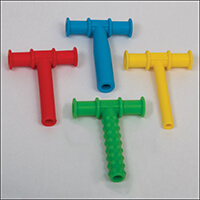Our therapy putty is great for many reasons: developing a pincer grasp, picking things up, strengthening muscles, and hand therapy, among others.
Parents will often get instructions from their child’s therapist to get putty for hand strengthening. One of the questions we get the most is:
“Which color putty is best for my child?”
Putty color is dependent on the resistance.
LIGHT BLUE is the softest:
The softest putty is best for people who are very weak in the hands.
You also want to have enough resistance to strengthen the hand, so if this one is too soft you can move up to the light green.
Buy enough putty so you can hide things in it (like mini animals!). Also, when someone has limited range in their hand, we want them to have enough putty to be able to grasp it.
(Be careful – the light blue putty can develop a string when you pull it, and can stain surfaces – see this list for recommendations to get it out.)
LIGHT GREEN is medium/soft
DARK BLUE is firm
DARK GREEN is super firm
We can hardly cut and package the firmest putty!
The firmest putty is great for adolescents with behavioral problems. They are often so agitated, they need that kind of heavy work/proprioception. They use it as a means of intensity. They need that intensity – similar to music.
A less resistant putty doesn’t require the effort that an adolescent might need.
The power fist is also fun for the kids!
“My child doesn’t like this color – can I get the other one?”
We color our putties so it’s easy for you to tell which strength you need – “the light blue one” can be your go-to if you forget the exact resistance.
You can work your way up in resistance/color – once the hand gets stronger, you will need a firmer putty!
“How do I get putty out of [x]?”
We get calls on that all the time – it’s another one of our biggest questions. We suggest using the putty in the kitchen – it is silicone based and will come off of hard surfaces easily!
If you do end up with a stain on fabric, stuck in hair, etc., we have compiled a list of suggestions to get it out!
 Are you in New England? Curious about our Saturday Morning Seminar Series?
Are you in New England? Curious about our Saturday Morning Seminar Series?
